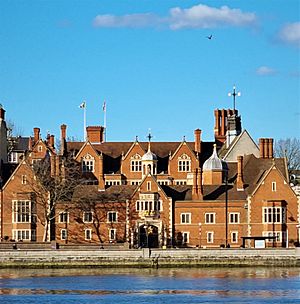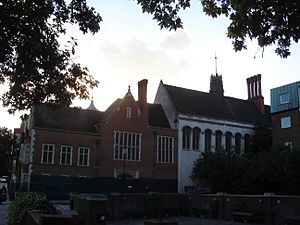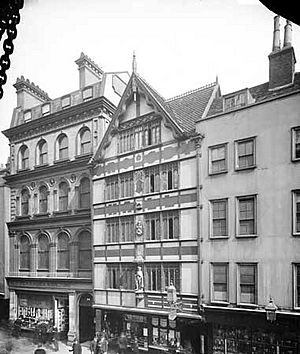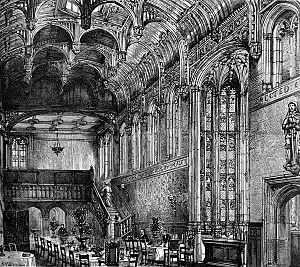Crosby Hall, London facts for kids
Quick facts for kids Crosby Moran Hall |
|
|---|---|

Crosby Moran Hall in London
|
|
| Location | Cheyne Walk, Chelsea, London |
| Built | 1466 (Great Hall and Parlour) 1910 (re-erection) 1925–26 (North Range) 1996–2021 (remainder) |
| Built for | Sir John Crosby (1466) |
| Restored | 1910; 1988–2021 |
| Architect | Walter Godfrey (1910) |
| Architectural style(s) | Medieval, Tudor |
| Owner | Christopher Moran |
|
Listed Building – Grade II*
|
|
| Designated | 24 June 1954 |
| Reference no. | 203744 |
| Lua error in Module:Location_map at line 420: attempt to index field 'wikibase' (a nil value). | |
Crosby Hall is a very old and important building in London. Its main part, the Great Hall, was built way back in 1466. It was first known as Crosby Place and stood in an area called Bishopsgate in the City of London.
In 1910, this amazing old hall was carefully moved, stone by stone, to its current spot in Cheyne Walk, Chelsea. Today, it's part of a private home, which was renamed Crosby Moran Hall in 2021. The Great Hall and some parts added in 1910 and 1925–1926 are considered very important historical structures. Even though it's not in its original place, it's the only example of a medieval merchant's house from the City of London that still exists. Between 1988 and 2021, the Great Hall was fixed up, and more buildings were added to create the complex you see today.
Contents
History of Crosby Hall
Crosby Hall in Bishopsgate
The Great Hall is the only part left of a large medieval house called Crosby Hall. It was built in 1466 in Bishopsgate, in the City of London. A wealthy wool merchant and city leader named Sir John Crosby built it. He finished the building in 1472. Sir John died in 1475, and in 1476, the hall was left to his wife, Lady Crosby.
Richard III's Time
By 1483, Richard III, who was then the Duke of Gloucester, took over the Bishopsgate property from Lady Crosby. He used it as one of his homes in London, especially during the time of the Princes in the Tower.
When Richard III arrived from York in May 1483, people said he stayed at Crosby Hall. The Mayor and citizens of London met him there to offer him the crown. It's even mentioned in William Shakespeare's famous play Richard III. In the play, King Richard refers to Crosby Hall (then called Crosby Place) several times.
Tudor Period Life
John Stow wrote in his Survey of London (1598) that Crosby Hall was "very large and beautiful" and the tallest building in London at the time.
In 1501, Catherine of Aragon stayed at Crosby Hall with her group when she arrived in England to marry Arthur, Prince of Wales, the son of King Henry VII. At that time, Sir Bartholomew Reade, who was the Lord Mayor, owned Crosby Hall. He used it as his main house and held grand parties there for important visitors.
Later, Crosby Hall belonged to Thomas More, who was a top advisor to King Henry VIII. It's often thought that More wrote part of his famous book Utopia while at Crosby Hall, but this is probably not true.
In 1523, Thomas More sold his lease of the hall to his friend, Antonio Bonvisi. Bonvisi made sure the mansion was protected even during big changes like the Dissolution of the monasteries, when many church properties were taken by the King. In 1547, Bonvisi leased the mansion back to Thomas More's nephew and son-in-law.
William Shakespeare lived near Crosby Hall and would have seen it often. He likely knew about Bonvisi, and the name Antonio appears in his plays.
In 1594, a rich city leader named John Spencer bought Crosby Hall. He made the building even better and used it for his mayoral duties. He was known for hosting fancy dinners with important guests. Spencer entertained Queen Elizabeth I, Shakespeare, and many other famous people and ambassadors.
In 1601, Sir Walter Raleigh, a trusted advisor to Queen Elizabeth I, stayed at Crosby Hall. Other important people who lived there during this time included the poet Mary Sidney, who was a very famous writer. She likely lived there from 1609 to 1615. Her literary friends, including Shakespeare and Ben Jonson, were guests at Crosby Hall.
English Civil War and Fire
During the English Civil War, Sir John Langham, a merchant and supporter of Parliament, lived at Crosby Hall. It was used as a temporary prison for Royalist prisoners.
Crosby Hall survived the Great Fire of London in 1666. However, in 1672, it was badly damaged by another fire. Only the Great Hall and one other part survived. The owner decided the house was not fit to live in. He divided the Great Hall, giving one part to a church group and another part to the East India Company for offices and storage. The damaged parts were torn down.
From 1621 to 1638, the Hall was the main office for the East India Company.
Saving the Hall
By the 1830s, the Hall was starting to fall apart. People started a campaign to save it. A committee led by Alderman W. T. Copeland raised some money. But most of the money needed came from one woman, Maria Hackett. She took over the lease and paid for the repairs herself.
In 1868, Crosby Hall was turned into a fancy restaurant and bar. It was very popular. In 1907, a bank bought the property and planned to tear down the old building to build new offices. This caused a huge protest, and another campaign began to save Crosby Hall.
Crosby Hall in Chelsea

In 1910, the medieval Great Hall was saved from being destroyed. It was carefully taken apart, stone by stone, and moved from Bishopsgate to its current location in Chelsea. The land for the new site was given by the London County Council. The bank that bought the Bishopsgate site paid for the hall to be taken apart, cataloged, and stored. The architect Walter Godfrey was in charge of moving and restoring the building. New brick additions were built around it in a style that looked old. The Queen Mother, who was then the Duchess of York, officially opened Crosby Hall at its new Chelsea site in 1926.
World War I Refuge
During World War I, Crosby Hall became a safe place for Belgian refugees who had to leave their homes and come to Britain. The Chelsea War Refugee Committee helped them there. The writer Henry James said that Crosby Hall's "almost incomparable roof has arched all this winter and spring [1914-1915] over a scene . . . more pathetic than any that have ever drawn down its ancient far-off blessing." Concerts were also held at Crosby Hall to help the exiles. A special memorial inside Crosby Hall remembers this time and includes a poem by a Belgian poet.
University Women's Home
The British Federation of University Women (BFUW) rented Crosby Hall for a long time. They hired Walter Godfrey to build a tall residential building next to the Great Hall between 1925 and 1927. This building was used as a hall of residence for women university students visiting London. Many of these women received scholarships to study there.
One student, Berta Karlik, a physicist, said that for many foreign women, their year at Crosby Hall was "one of the greatest experiences of their lives."
World War II Support
When Nazism grew in Germany and laws were passed against Jewish people, Crosby Hall became a vital place of support for women academics forced to leave Germany. The BFUW raised money to help them. They were able to offer new scholarships and other aid. Many women, including Emmy Klieneberger-Nobel and Betty Heimann, received help.
Erna Hollitscher, another woman who stayed there, said: "I cannot describe what it meant to me and other refugees when we were allowed to stay there, after the persecution and hatred that we had undergone in 'Greater Germany'. In Crosby Hall we were not only tolerated but welcomed, and we found an atmosphere of kindness and understanding."
Crosby Hall was used for the war effort during World War II but reopened in 1946.
New Ownership
The property later belonged to the Greater London Council (GLC). When the GLC was closed down in 1986, Crosby Hall was put up for sale.
In 1988, Christopher Moran, a businessman, bought Crosby Hall. He is also the Chairman of Co-operation Ireland. Before he bought it, the front of the site was open to Cheyne Walk and the River Thames, and its garden was open to the public. Moran wanted to build a new building at the front and turn the complex into a luxury home. This plan caused some debate, but it was finally approved in 1996. Moran paid for the building's restoration, including fixing the Great Hall's old stone. The garden was also restored using only plants found in Tudor England.
Famous People Who Lived at the Original Site
- Richard III of England, Duke of Gloucester, 1483
- Catherine of Aragon, 1501
- Bartholomew Reade, Lord Mayor of London, 1501–1505
- Sir Thomas More, Lord High Chancellor of England, 1523–4
- William Roper (son-in-law of Thomas More), 1547
- John Spencer, Lord Mayor of London, 1594
- Sir Walter Raleigh, 1601
- The Earl of Northampton between 1609 and 1671
- Dowager Countess of Pembroke, Mary Sidney from 1609–1615
- Headquarters of the East India Company, 1621–38
Images for kids
-
Crosby Hall at Chelsea from the east, showing the original Great Hall, faced in Portland stone, to the right; with 1990s additions in brick to the left




